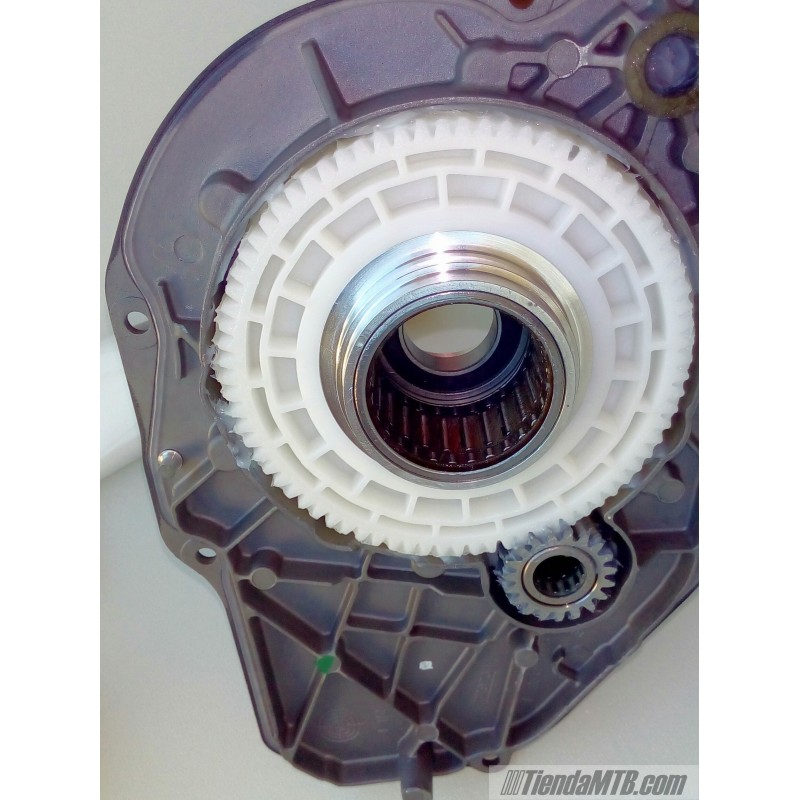

Such an electromechanical brake booster offers the possibility of a variable force translator. To keep up its pedal travel/pedal force characteristic during the purely regenerative (or “recuperative”) braking, of the purely hydraulic braking or in transition phases (“blending”), in the present invention, an electromechanical brake booster is used. Thus, the present invention improves the efficiency of recuperation of a brake system operated by it, and raises its service life. This raises the efficiency of the brake system and counteracts wear of the brake linings (such as brake disks or brake areas). Using the present invention, this residual pressure is able to be reduced, so that undesired residual grinding torques on the wheel brakes are able to be eliminated/prevented. Because of the return spring, however, during the displacement of the brake fluid volume into the at least one low-pressure accumulator device, a residual pressure is created at the wheel brakes of approximately 1 to 3 bar. In order to make possible the emptying of the low-pressure accumulator device when needed, it has a return spring as a rule, which is able to apply a so-called minimum expulsion force.
IBOOSTER GEN 2 DRIVER
In one execution of the present invention, the brake fluid volume displaced from the master brake cylinder by the driver using the brake pedal (from here on, the concepts “brake fluid” and “hydraulic fluid” will be used synonymously) at corresponding availability of a sufficient regenerative braking torque is displaced into at least one low-pressure accumulator device (such as a low-pressure accumulator chamber), in order to prevent an hydraulic brake pressure buildup in the wheel brakes.
IBOOSTER GEN 2 GENERATOR
At the same time, the present invention ensures that, based on a speed-dependent availability of the (absolute) braking torque of an electric generator (especially at high speeds and shortly before reaching a standstill) in a transitional manner, the driver's braking request is able to be satisfied with the aid of an additional hydraulic brake torque of the wheel brake cylinder. The present invention supplies suitable actuating strategies for regenerative braking. In order to be able to carry out the function “regenerative braking” without a reaction, perceptible by the driver, in the form of deceleration fluctuations or pedal force changes or route changes, at the same time maintaining optimal utilization of the generator potential, special actuating strategies and/or changes in the brake system are advantageous. To reduce the energy demand in motor vehicles which are driven exclusively or additionally by an electric motor, braking may be carried out, at least partially, with the aid of an electric motor which is operable as a generator. The present invention creates a method for operating a brake system for a vehicle, as well as a control device for a brake system of a vehicle, and a brake system for a vehicle. In this way, regenerative braking carried out by the electric drive is supposed to be blendable. In addition, by opening the wheel outlet valve of the hydraulic brake system, the pressure medium displaced from the master brake cylinder is supposed to be transferred via the at least one wheel brake cylinder into at least one storage device, which may be a low-pressure accumulator. During the braking of the vehicle, while using the electric drive for simultaneously charging a battery, the hydraulic brake torque exerted upon at least one wheel by the at least one wheel brake cylinder of the hydraulic brake system is supposed to be reduced/prevented in spite of an operation of the brake pedal by the driver. 196 04 134, a method and a device are described for controlling a brake system of a motor vehicle having an electric drive. The present invention relates to a method for operating a brake system for a vehicle and a control device for a brake system of a vehicle.


 0 kommentar(er)
0 kommentar(er)
